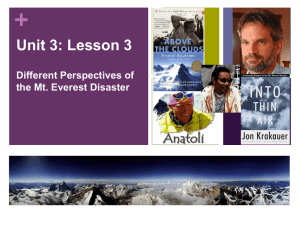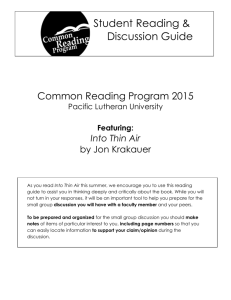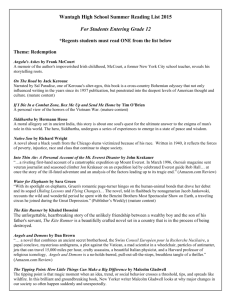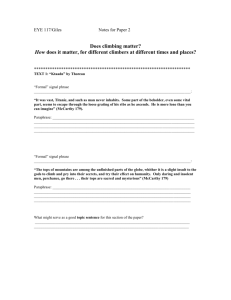Into Thin Air draft 01
advertisement
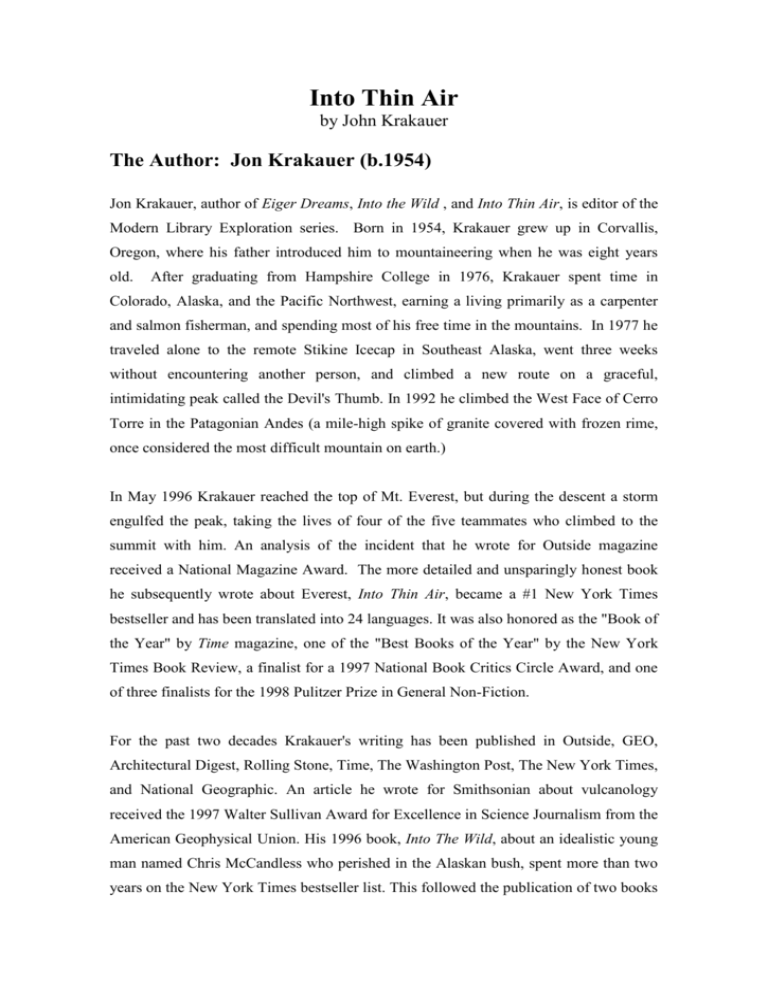
Into Thin Air by John Krakauer The Author: Jon Krakauer (b.1954) Jon Krakauer, author of Eiger Dreams, Into the Wild , and Into Thin Air, is editor of the Modern Library Exploration series. Born in 1954, Krakauer grew up in Corvallis, Oregon, where his father introduced him to mountaineering when he was eight years old. After graduating from Hampshire College in 1976, Krakauer spent time in Colorado, Alaska, and the Pacific Northwest, earning a living primarily as a carpenter and salmon fisherman, and spending most of his free time in the mountains. In 1977 he traveled alone to the remote Stikine Icecap in Southeast Alaska, went three weeks without encountering another person, and climbed a new route on a graceful, intimidating peak called the Devil's Thumb. In 1992 he climbed the West Face of Cerro Torre in the Patagonian Andes (a mile-high spike of granite covered with frozen rime, once considered the most difficult mountain on earth.) In May 1996 Krakauer reached the top of Mt. Everest, but during the descent a storm engulfed the peak, taking the lives of four of the five teammates who climbed to the summit with him. An analysis of the incident that he wrote for Outside magazine received a National Magazine Award. The more detailed and unsparingly honest book he subsequently wrote about Everest, Into Thin Air, became a #1 New York Times bestseller and has been translated into 24 languages. It was also honored as the "Book of the Year" by Time magazine, one of the "Best Books of the Year" by the New York Times Book Review, a finalist for a 1997 National Book Critics Circle Award, and one of three finalists for the 1998 Pulitzer Prize in General Non-Fiction. For the past two decades Krakauer's writing has been published in Outside, GEO, Architectural Digest, Rolling Stone, Time, The Washington Post, The New York Times, and National Geographic. An article he wrote for Smithsonian about vulcanology received the 1997 Walter Sullivan Award for Excellence in Science Journalism from the American Geophysical Union. His 1996 book, Into The Wild, about an idealistic young man named Chris McCandless who perished in the Alaskan bush, spent more than two years on the New York Times bestseller list. This followed the publication of two books by Krakauer in 1990: Eiger Dreams, a collection of his mountaineering essays, and Iceland: Land of the Sagas, a book of his photographs. In 1998 Krakauer established the Everest '96 Memorial Fund at the Boulder Community Foundation, endowing it with royalties from Into Thin Air. Created as a tribute to his companions lost on Everest, the fund provides humanitarian aid to the indigenous peoples of the Himalaya and supports organizations working to preserve the natural environment throughout the world. Krakauer also serves on the boards of the American Himalayan Foundation and the Alex Lowe Charitable Foundation. In 1999 Krakauer received an Academy Award in Literature from the American Academy of Arts and Letters--a prestigious award intended "to honor writers of exceptional accomplishment." According to the Academy's citation, "Krakauer combines the tenacity and courage of the finest tradition of investigative journalism with the stylish subtlety and profound insight of the born writer. His account of an ascent of Mount Everest has led to a general reevaluation of climbing and of the commercialization of what was once a romantic, solitary sport; while his account of the life and death of Christopher McCandless, who died of starvation after challenging the Alaskan wilderness, delves even more deeply and disturbingly into the fascination of nature and the devastating effects of its lure on a young and curious mind." Krakauer's latest book, which he has spent the last four years researching and writing, is Under The Banner of Heaven: A Story of Violent Faith, published by Doubleday in July 2003. As a child in Oregon, many of the author's playmates, teachers, and athletic coaches were Latter-day Saints. Although he envied the unfluctuating certainty of the faith professed so enthusiastically by these Mormon friends and acquaintances, he was often baffled by it, and has sought to comprehend the formidable power of such belief ever since. The upshot of this lifelong quest is Under The Banner of Heaven, in which Krakauer examines the nature of religious passion through the lens of Mormon Fundamentalism. The Book Into Thin Air originally began as an article for Outside magazine. Krakauer, an experienced mountain climber, was sent by the magazine to write about the commercialism surrounding Mount Everest. Rather than report from Base Camp, as was the original arrangement, Krakauer convinced the magazine to pay for his attempt to summit the mountain - a feat which had always been a dream of his. The tragedy that befell the climbers later became the focus of his article, but after its completion, Krakauer felt there was much more that needed to be told. He began to revise existing information by doing further research and contacting other climbers, allowing him to gather new, more thorough details of the account. Characters Jon Krakauer - The narrator and the author. Krakauer is hired to write an article about Mount Everest for Outside Magazine, and ends up joining the most disastrous Everest expedition in history. He survives, and writes a novel intended to provide a thorough and accurate account of the disaster. Rob Hall - The head guide of Adventure Consultants, the Everest climbing service that guides Krakauer up the mountain. Hall is a respected climber, having summited the tallest mountain in each of the seven continents in a period of only seven months. Andy Harris - A guide in Rob Hall's expedition. Harris is from New Zealand, and becomes a friend to Krakauer during the climb. Krakauer holds himself responsible for Harris's death. Mike Groom - An Australian guide with Adventure Consultants. Groom gets lost with a group of clients during the descent, but survives. He also leads Beck Weathers down the mountain when Beck goes blind. Ang Dorje Sherpa - Rob Hall's number one Sherpa. Ang performs with near heroics frequently during the ascent, always helping other climbers and exhausting himself with the effort he exerts for others. He attempts to find Hall during the summit, but cannot climb high enough. Doug Hansen - A client with Adventure Consultants. Hansen is a postal worker who climbed Everest one year before but had to turn back just a few hundred feet from the summit. He and Krakauer become close friends. Hansen is at the summit with Hall when the storm hits. Beck Weathers - One of the novel's heroes, Weathers is a doctor with a passion for mountain climbing. He is left for dead after a group of clients get lost in a storm, but amazingly regains consciousness and manages to get to camp. Despite suffering numerous physical ailments he descends the mountain and survives. Yasuko Namba - Yasuko Namba and Beck Weathers are left for dead when their group gets lost on the way down the mountain. Namba is a Japanese woman whose attempt to climb Everest gained much notoriety in Japan. Unlike Weathers she cannot summon the strength to return to camp, and dies. Stuart Hutchinson - A Canadian client with Adventure Consultants. Hutchinson is a strong climber, and when Hall and the other guides are stranded on the mountain, he steps in as leader. Scott Fischer - The head guide of the Mountain Madness expedition group. Fischer and Hall are friends and competitors. Fischer is a renowned climber infamous for having survived some terrible falls. Fischer gets seriously ill about halfway through the climb, but climbs undeterred. Anatoli Boukreev - A guide with Scott Fischer's group, Boukreev is a world-respected climber who had previously summited Everest with no supplemental oxygen. He rescues the group of climbers stranded in the storm, but is also thought to have contributed to the disaster by descending far ahead of his clients. Neal Beidleman - Another excellent climber, Beidleman is a guide with Fischer's service. He is consistent as a climber and a guide, and is instrumental in saving the lives of his clients during the summit descent. Lopsang Jangbu Sherpa - Fischer's main Sherpa. Lopsang is exceedingly loyal to Fischer, and helps secure ropes and haul supplies all the way up the mountain. Most notably, he pulls Sandy Pittman up the mountain when she is too tired to climb herself. Lopsang tries to save Fischer after the storm hits, but cannot. Tim Madsen - Madsen is a client with Scott Fischer's guide service. He is among the clients lost during the storm, and he stays behind to look after the ailing climbers while Beidleman goes back to find Boukreev who then rescues Madsen's group. Ian Woodall - The leader of the South African expedition. It is rumored that Woodall is dishonest, corrupt and somewhat crazy, and Krakauer's group has a number of unpleasant encounters with Woodall, including during the storm when Woodall refuses to loan his radio for use in a rescue attempt. Makalu Gau - The leader of the Taiwanese climbing group. The Taiwanese are known to be inexperienced and dangerous climbers, and during the storm at the summit Gau is abandoned by his Sherpas. Members of Hall and Fischer's teams save Gau. Sandy Pittman - An employee of NBC who is along on the expedition to dispatch media files. This is her third attempt to climb Everest and she was at one time in contention to be the first woman to successfully climbed the highest mountain in each of the seven continents. Lopsang virtually drags her up the mountain at one point, but she reaches the top. Synopsis Outside Magazine hires Jon Krakauer, writer and mountain climber, to write an article about the commercialism that surrounds Mount Everest. Krakauer decides he wants to attempt to climb the mountain, and becomes part of the most disastrous Everest expedition in history. Krakauer joins a climbing service called Adventure Consultants, led by Rob Hall. The function of the service is to accelerate the acclimatization process and guide the climbers successfully to Everest's summit. The climb is structured into five camps: Base Camp, Camp One, Camp Two, Camp Three and Camp Four. After spending weeks at Base Camp, the group makes a number of trips up to the other camps to speed up the acclimatization process. At the start of May, the group begins their push for the summit. As the climb progresses, Krakauer details the members in his group, his guides and other Everest expeditions. He tries to compile a continuous timeline of the events that occur in the weeks they are on the mountain. All of the clients have difficulty adjusting to the altitude, begin to tire easily, lose weight and move slowly. Their experience in mountain climbing and at high altitudes varies - some of them are quite capable, while others are inexperienced and very dependent on the guides. Despite several mishaps, the first fatality does not actually occur until Chapter 11. After that point, however, death becomes a reality that all the climbers become familiar with. It's during the push for the summit when everything begins to fall apart. Rob Hall sets a 2:00 pm turn-around time, meaning that those unable to reach the summit by that time must turn around, no matter how close to the top. Only Krakauer and a few other climbers actually manage to make it to the top before 2:00 pm. Others reach the top as late as 4:00 pm and the turn-around time is not enforced. Among the later arrivals to the summit is Rob Hall and another member, Doug Hansen. They arrive just after another group of climbers, led by Scott Fischer. That afternoon a storm hits the summit, but Krakauer is only caught by the tail end of it before he successfully reaches the safety of Camp Four. Krakauer is well ahead of most of his teammates and is unaware of their imminent danger. Hall and Hansen become stranded, and Hansen runs out of oxygen and is unable to continue. Another group gets lost in the blizzard and later, an assistant guide rescues all but two, who are left behind, presumed dead. Fischer also gets stranded, and when he is finally found, he is dead. Hansen dies and one of Hall's Sherpas tries to rescue Hall, but cannot climb high enough. A guide assistant dies trying to rescue Hall and Hansen. One of the two clients left for dead, Beck Weathers, miraculously makes it back to camp and survives the ordeal. He eventually undergoes amputation and surgery for his injuries. In all, a dozen people die on Everest that season, and Krakauer, originally there to report on the business of taking people up the mountain, is unable to forget what he sees. After the article is published, Krakauer writes Into Thin Air because he feels there is more for him to say. He has done thorough research and held interviews with all of the survivors, and has information not available when he wrote the article. His belief is that all that happened on the mountain deserves to be told in as detailed and accurate a manner as possible. He spends a great amount of time reflecting on what happened and how his life has been changed by it. He struggles with survivor's guilt and a redefined view on mortality and raises questions about events on the mountain that might not have answers. Krakauer is sensitive toward friends and families of the victims, but is undeterred from detailing all the events, whether heroic, selfish or tragic. Themes Commercialism on Everest Krakauer is hired to report on the commercialism on Everest, but the business he encounters there is beyond what he imagined. The commercialism manifests itself in a number of ways: the tourist revenue collected by Nepal and Tibet, the ungodly amounts of money the guiding services charge each of the clients, the competition among Sherpas to get hired by the guiding services, the competition between guide services for media attention and the broadcast of information and images throughout climbing expeditions. Even Krakauer's position underscores just how commercial the business has become he is folded into the process, paid for reporting on commercialism. Hall and Fischer's guide services compete to have Krakauer in their group because of the media attention and endorsements they could receive after Krakauer's article is published. The commercialism on the mountain also distorts the requirements for climbers. Many of them are inexperienced and would undoubtedly never make it to the top without a guide. The one unifying characteristic shared by all of the climbers is that they have money - enough to shell out $65,000 a piece for their shot at the top. Trust and Loyalty Among Teammates Krakauer specifies early on how important it is to be able to trust one's teammates: "In climbing, having confidence in your partners is no small concern. One climber's actions can affect the welfare of the entire team" (47). On this expedition, Krakauer climbs primarily with strangers and he is uncomfortable putting his life in the hands of people whose presence on the mountain is not necessarily a tribute to their climbing skills. Throughout the book, when one client gets in trouble, another must help immediately. When they suffer the effects of hypoxia and mind-altering high altitudes, they have to check each other and watch each other's backs. Krakauer is afraid that, because many of the climbers are inexperienced, he will have to watch out for them while they are of little help to him. Krakauer recognizes that the most important element of all is trust in one's guide, who is responsible for keeping all of the team members together, functioning as a group. During the climb, particularly the descent, trust between teammates results in the survival of some of the clients and the breakdown of that trust results in the death of others. While related to trust, loyalty is so important that it must be stressed separately. On Everest, loyalty basically means that a climber will risk his or her own life to help another. Guides by definition are loyal to their groups. Countless times during the climb, clients get into trouble and their guides rush to their assistance, at times climbing for hours and for thousands of extra feet to perform rescues, bring oxygen, or assist in climbing. During those times, loyalty means not hesitating to help someone else for fear of one's own safety, and the guides and clients that are most trusted among the group are the ones who display loyalty. Lopsang Sherpa is fiercely loyal to Fischer, almost to the exclusion of other climbers. When Fischer is lost on the summit, Lopsang's search for him is not deterred, even by the deadly weather. Hall is similarly loyal to Hansen, refusing to leave Hansen at the summit. Hall's loyalty to Hansen eventually results in his death - he could have left Hansen at the top and climbed down, but he does not even consider it. Andy Harris's loyalty to Hall and Hansen causes his death too, as he becomes stranded trying to bring oxygen to the two men. Nearly all of the rescue attempts on Everest require an enormous amount of loyalty, because every rescue is potentially deadly for all who become involved. Solitude and Self-Reliance Despite the importance of trusting one's teammates, Krakauer comes to the realization that in fact, each climber is there for him or herself, and that it is possible for one climber to trust another too much. Krakauer knows that it is unlikely that the other clients would be capable of helping him were he to get stranded, and he knows that in order to be as safe as possible, self-reliance is essential. Thus, Krakauer often breaks away from the group, climbing ahead of his teammates. He avoids packs and traffic jams and relies on his own mountain climbing experience throughout the expedition. Almost without exception, the people who died on Everest during the expedition died deaths of solitude. Fischer is stranded, alone. Hall and Hansen are stuck at the summit, but Hansen dies early on, leaving Hall by himself, radioing helplessly down to Base Camp for help. Weathers is left for dead twice, with no one looking after him. In fact, even on the brink of death Weathers is cognizant of the fact that: "I was in deep shit and the cavalry wasn't coming so I better do something about it myself'" (329). Arrogance: Believing that nature can be tamed Ultimately, Krakauer concludes that sheer arrogance is in part to blame for the tragedy that takes place on Everest. Fischer even claimed to have "built a yellow brick road to the summit" (86). The entire guiding business is built on the concept that the acclimatization process can be sped up into a compact amount of time, making it possible for almost anyone to reach the top. Hall "bragged on more than one occasion that he could get almost any reasonably fit person to the summit" (354). Confidence is essential in running a guide service and attracting clients, but Hall and Fischer's apparent belief that they had reduced conquering Everest to a science is foolhardy. Their arrogance also caused their clients to lower their guards and not fully appreciate the risks of the expedition. For all of the ways that the guide service made climbing easier - speeding up acclimatization, installing ropes along hard passes and setting up camps - a number of variables remain completely out of their control. A falling boulder kills a Sherpa on this expedition. Avalanches and storms strike without warning, and no matter how competent a guide is, he or she cannot avoid these pitfalls. Believing that one has all aspects of summiting Everest under control is detrimental to any climb; one cannot lower one's guard or lose sense of the enormity of the risk. Quotes Chapter 3 "I suspected that each of my teammates hoped as fervently as I that Hall had been careful to weed out clients of dubious ability, and would have the means to protect each of us from one another's shortcomings." Chapter 4 "Most of the people who live in this rugged country seem to have no desire to be severed from the modern world or the untidy flow of human progress." Chapter 20 "Finally I woke up enough to recognize that I was in deep shit and the cavalry wasn't coming so I better do something about it myself." Chapter 21 "Mortality had remained a conveniently hypothetical concept, an idea to ponder in the abstract. Sooner of later the divestiture of such a privileged innocence was inevitable, but when it finally happened the shock was magnified by the sheer superfluity of the carnage…" Epilogue "They helped outsiders find their way into the sanctuary and violate every limb of her body by standing on top of her, crowing in victory, and dirtying and polluting her bosom." Suggested Essay Topics How inevitable is disaster in an expedition like the one Krakauer joined in 1996? What steps could be taken to make such expeditions safer? Why are the surviving members of the 1996 expedition met with so much criticism and negative press? In what ways do predominantly good characteristics become deadly during the course of the narrative? Is Krakauer's survival guilt purely a product of him surviving, or a reflection of personal responsibility in the tragedy that occurred? What is the significance of the fact that more guides than clients were lost on the mountain during the expedition?
